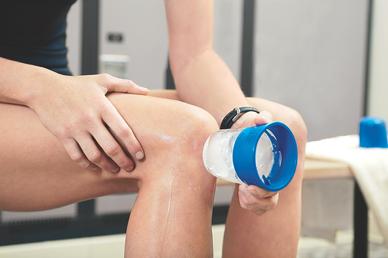Runner’s Knee
Last Updated on October 23, 2023 by The SportsMD Editors
Runner’s knee is a term used to describe a constellation of symptoms of knee pain that is frequently encountered in running athletes. Other terms that have been used to describe this condition are “anterior knee pain”, “chondromalacia patella”, or “patellofemoral pain syndrome (PFPS).” Runner’s knee involves the kneecap, quadriceps tendon, patellar tendon, and the associated soft tissues that are critical to extension of the knee. Historically, “runner’s knee” was attributed to irritation and softening of the cartilage lining on the undersurface of the kneecap (“chondromalacia”). More recently, however, it has been recognized that overloading of the underlying (“subchondral”) bone can be a substantial source of pain, as it has a rich nerve supply. The soft tissues and fat pad in the front knee can be causes of pain as well.
Who gets Runner’s Knee?
While classically associated with long-distance running, any activity that places significant stresses on the front of the knee joint (“patellofemoral”) can result in “runner’s knee”. This includes repetitive jumping sports like basketball or volleyball, as well as skiing, cycling, and soccer. The repetitive pressure and stress between the femur and patella in these sports can result in softening of the cartilage and abnormal loading of the underlying bone.
Symptoms
Runner’s knee symptoms are associated with activity-related pain in the front of the knee and around the kneecap. While the pain develops during athletic activity, it can often be most pronounced afterward during a period of rest. Pain is also felt after sitting for a long period of time with the knees bent – the bent position actually increases the pressure between the kneecap and femur. For the same reason, marathon runners will often paradoxically complain of greater difficulty running downhill rather than uphill. Kneeling, squatting, or direct pressure on the front of the knees may be uncomfortable as well.
Causes
The kneecap and its cartilage is subject to very high forces with daily activities, and any injury to the cartilage or factors which result in increased pressure between it and the thigh bone (“femur”) can increase the risk of “Runner’s Knee”. These include:
• Malalignment of the kneecap and/or leg
• Subluxation or dislocation of the kneecap
• Direct trauma to the kneecap
• Overuse with running and jumping activities
• Wide hips and/or “knock knees” (valgus) resulting in maltracking of the kneecap
• A weak quadriceps/vastus medialis muscle
• Flat feet (“pronated” feet)
In certain cases, runner’s knee results from irritation or injury to the soft tissue around the kneecap. For this reason, inadequate muscle strength and/or stretching of the thigh and calf muscles can predispose to “Runner’s Knee” as well.
Exercises
While certain predisposing factors such as kneecap and leg alignment are not in the control of an athlete, other preventative measures can be taken to minimize the risk of “runner’s knee”. Runner’s Knee Exercises include:
- Vastus medialis and quadriceps strengthening – a strong quadriceps and, specifically, the vastus medialis muscle will improve the tracking of the kneecap and help to minimize contact pressures between the kneecap and thigh bone.
- Keep your weight down – the patellofemoral joint experiences forces that are 8 to 10 times our body weight, such that even small reductions in weight can significantly reduce the forces on the kneecap. Ten pounds of weight loss can be as much as 80 to 100 pounds less force of the kneecap when climbing or descending stairs.
- Stretch before running or jumping activities – Strains of the patellar tendon, quadriceps tendon, or other soft tissues that stabilize the patella can cause significant anterior knee pain. Warming up and stretching both before and after exercise can help to prevent strain injuries to these structures.
- Wear proper shoes and orthotics – Flat feet (“pronated” feet) can predispose to maltracking problems and knee pain. Orthotics to reconstitute the arch of the foot can help to alleviate these symptoms. High heels can also worsen anterior knee pain and should be avoided if you have “runner’s knee” symptoms.
- Plan for a good running surface – Running on a flat surface without steep, downhill slopes can help to prevent significant stress on the knee cap. Even, padded surfaces and good running shoes can help as well.
Diagnosis
Usually, the diagnosis of “runner’s knee” can be made in athletes based on the history and physical examination of the knee by your sports medicine specialist. The exam will evaluate the stability of the kneecap as well as alignment of the leg. Signs of tenderness under the kneecap and/or instability will be assessed. Strength and tone of the quadriceps and hamstrings will also be determined. Flexibility of the feet and loss of the arch should also be noted as this will predispose to kneecap problems. X-rays, MRI, and CT scans can all be useful adjuncts depending on the examination findings and symptoms. Special views can show the position and alignment of the patella in its groove on the thigh bone (“trochlea”). Tilting of the patella that leads to abnormal contact pressures can be appreciated. If instability of the kneecap is suspected, CT scan can help to determine abnormalities in alignment and position. MRI is useful to evaluate for softening or injury to the cartilage on the kneecap and femur.
Treatment of Runners Knee
The first line of treatment for “runner’s knee” is typically nonoperative. Recommendations include:
- Avoid running down hills or down steep slopes or stairs that increase pressure on the kneecap.
- Ice and anti-inflammatory medications can certainly help to relieve the pain in the front of the knee.
- In certain cases, taping of the kneecap (“McConnell taping”) or use of stabilizing braces for the kneecap can help. These are particularly useful in the setting of instability of the kneecap.
- If the athlete has flat feet (“pronation”), orthotic inserts to reconstitute the arch can be extremely useful to alleviate symptoms.
- When the knee is pain-free, a course of rehabilitation for range-of-motion of the knee and strengthening of the quadriceps and vastus medialis muscle may be useful.

More Information: Read about sports injury treatment using the P.R.I.C.E. principle – Protection, Rest, Icing, Compression, Elevation.
However, exercises that are performed with the knee bent should be avoided, as the pressure beneath the kneecap is increased in this position. Instruction on preventative stretching exercises for the quadriceps, hamstring, and calf muscles is very important as well.
Surgery Option for Runners Knee
In rare circumstances, the knee will continue to be painful and refractory to all of the nonoperative measures described above. When the pain of “Runner’s Knee” prevents the athlete from returning to play, surgery may be considered. The specific treatment will depend on the underlying cause of the pain.
Arthroscopic (“minimally invasive” camera-based) surgery can be pursued to manage softening or damage of the articular cartilage of the kneecap and thigh bone. If there is accompanying instability of the knee cap, soft tissue reconstructive procedures or re-alignment of the leg (“osteotomy”) may be performed to improve the tracking of the patella. These may also be performed to relieve abnormally high pressures between the kneecap and femur.
Get a Telehealth Appointment or Second Opinion With a World-Renowned Orthopedic Doctor
 Telehealth appointments or Second Opinions with a top orthopedic doctor is a way to learn about what’s causing your pain and getting a treatment plan. SportsMD’s Telehealth and Second Opinion Service gives you the same level of orthopedic care provided to top professional athletes! All from the comfort of your home.. Learn more via SportsMD’s Telemedicine and Second Opinion Service.
Telehealth appointments or Second Opinions with a top orthopedic doctor is a way to learn about what’s causing your pain and getting a treatment plan. SportsMD’s Telehealth and Second Opinion Service gives you the same level of orthopedic care provided to top professional athletes! All from the comfort of your home.. Learn more via SportsMD’s Telemedicine and Second Opinion Service.
FAQs
Question: How do you fix runner’s knee?
Answer: The first line of treatment for “runner’s knee” is typically nonoperative. Recommendations include: Rest from running until pain goes away, ice and anti-inflammatory medications to reduce pain and inflamation, taping or bracing to protect the knee, consider orthodics, see a PT to get a specialized rehabilitation ptogram.
Question: What does runner’s knee feel like?
Answer: Runner’s knee can feel like a dull pain around the front of the knee and a rubbing, or grinding feeling. You may even hear a clicking sound around the kneecap.
Question: How long does runner’s knee take to heal?
Answer: On average, it takes 4 to 6 weeks to recover from runner’s knee. You can speed up the recovery process by strictly following the treatment protocols.
Question: Does runners knee go away?
Answer: Yes, but you should stop running until you no longer feel pain, Follow the treatment protocols and start slowly with smaller distances and a gadual build up.

